Tubes or transistors ? Whatever your prejudices, this article may make
you change your mind about how you view hybrid designs.
By MF.
Forget for the moment tubes, resistors, capacitors, and output transformers, but think about what your system is asked to do. Yes, you know the answer: your equipment should reproduce music as closely as possible to the way you'd hear it in a live performance. All the instruments should sound real, and you must receive the impression that they are being played right in front of you.
How is this done? Simple: you need a source, a preamp, a power amp, and a pair of speakers.
DESIGN APPROACH
Your equipment should be designed to offer the best musical performance possible depending on costs and on the technology you are willing to use. It is often said that tubes sound better than transistors. I think this is not completely true, since the quality of sound does not depend only on the devices you are using, but more on how they are used.
The approach when designing audio equipment is first of all to obtain the best electrical performance from the components you choose, and then to optimize the circuit for the best sound.
If you are not completely satisfied, abandon the first approach and look for a different design.
----------------------
ABOUT THE AUTHOR
MF is currently a student of electronic engineering at the Turin Polytechnic in Italy. He became involved with tube amplification in high school, and then was attracted to audio reproduction. In the summer of 1994 he built his first power amplifier, a KT88 push-pull based on the famous Leak TL50. Since then, he has designed and built a number of amps, including single ended designs.
-------------------------
Now, looking at a generic transformer-coupled tube power stage, you find that it has great handicaps: it is un able to supply large amounts of current to the load; its damping factor is very low; it phase-rotates in the low-frequency region; it is quite difficult to achieve an output power over 50-60W while still having good musical performance; finally, all of these and other parameters vary greatly depending on the regularity and nature of the load itself.
The list is long, but the greatest handicap is that tubes are unable to supply enough current to the load. This means that with some speakers you'll never obtain good driving (and listening) performance from a tube amp.
Now that the problem is clear, you can look for a solution. I am convinced that tubes do sound better than transistors, but the problem is how to achieve an exciting tube-sound driving performance from the power stage while avoiding the solid-state devices I need to use to affect the sound.
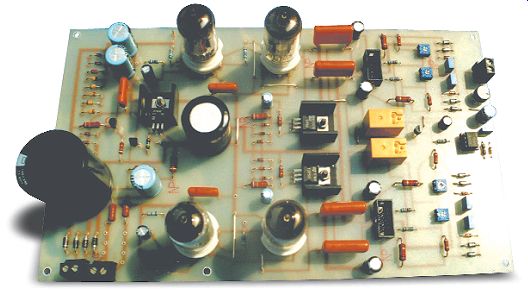
PHOTO 1: Top view of driver board with all tubes mounted.
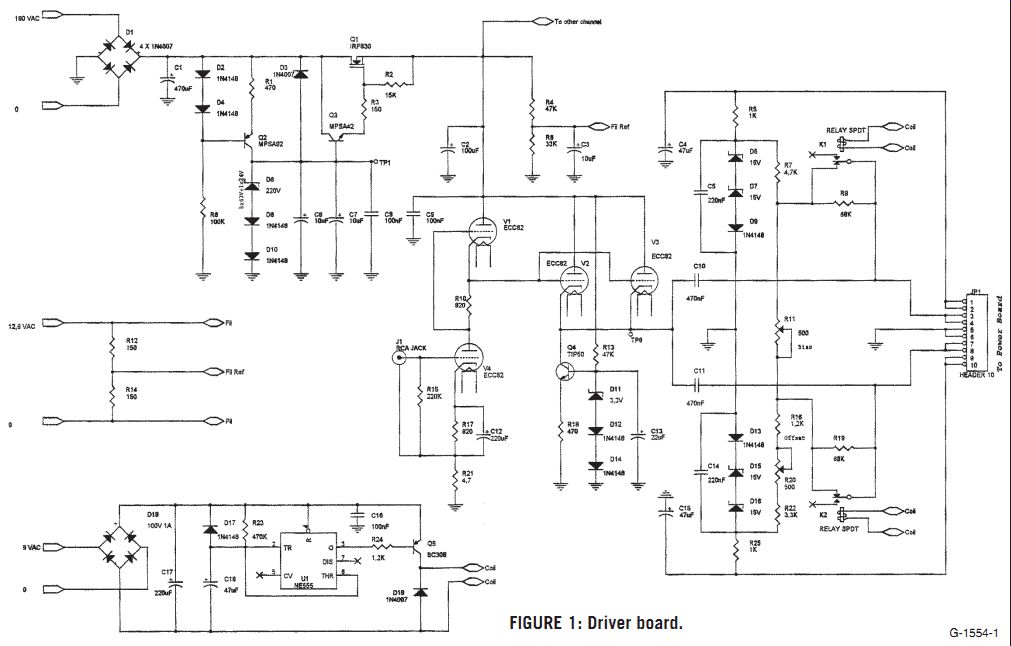
FIGURE 1: Driver board.
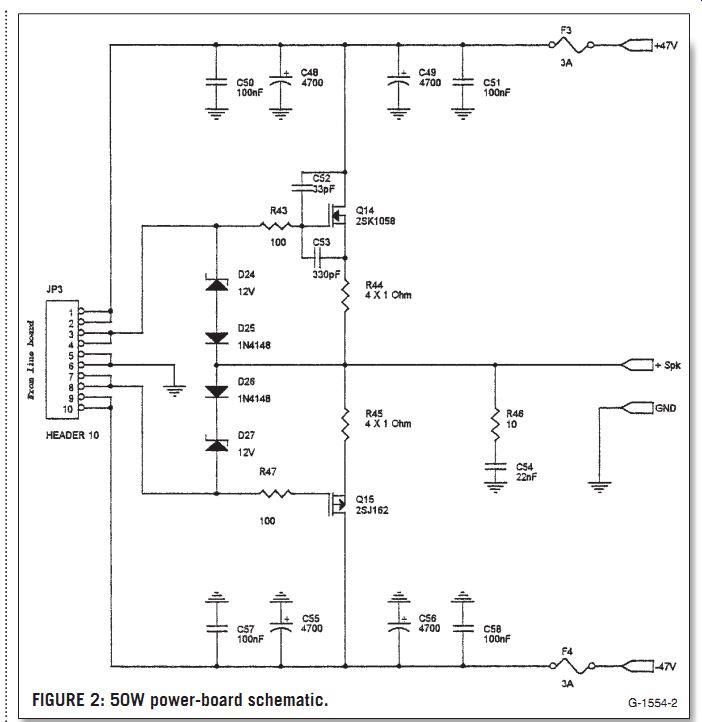
FIGURE 2: 50W power-board schematic.
VOLTAGE-AMPLIFIER STAGE
I can affirm that what makes good sound in an amp is mostly the first stage, the voltage amplifier. It adds gain, which means distortion, nonlinearity, and noise, but if carefully de signed to operate with all the rest of the amp circuitry, it can really make a difference. The most suitable device to use here is a tube; I chose an SRPP design because of its low distortion, consider able gain, low output resistance, striking dynamics, and good slew rate.
The power stage is less critical; after all, it exists only to move current and drive the speakers. My choice here was a complementary solid-state-follower configuration, since it has no voltage gain and almost no distortion; it can move a great amount of current and deliver high peaks of it to the load; it has a very high damping factor and low output resistance; and, finally, it's very reliable.
Now the question is: bipolar or MOSFET? Transistors are current driven. If you really wish to use them in your de sign, you need at least two current amplifiers to drive their bases, but this means more active devices that the precious signal must pass through, and this is not good for sound! Instead, MOSFETs are voltage driven, so you can derive the signal directly from the gain stage and apply it to their gates. Easy? Not at all! MOSFETs usually have huge source-to-gate and gate-to-drain capacitance, which means their gates will absorb current.
The input stages must be able to supply this current; otherwise, frequency response and dynamics will be seriously compromised.
I have focused on the main points of the design: a tube gain stage, a tough driver, and a MOSFET power stage; and if what I've said is right, you'll have an amp with superb driving performance that sounds very like tube equipment.
The driver stage is AC-coupled to the power stage, which offers an enormous advantage in that you can choose the number of devices your power stage will contain without changing anything in either the driver stage or bias net work, since MOSFETs are voltage driven. Now you are dealing not just with a single amplifier, but with a complete amplification system that allows you an output power of from 50-200W. All versions will have the same timbre, the same sound, but different power, de pending on how many devices you mount on the power stage.
This is exactly what I was looking for: an audiophile amplification system for my home-theater room. The 200W version powers the main speakers, and less powerful versions drive the other channels that are provided by a Dolby digital decoder.
AMPLIFIER DESIGN
One of my goals when I began to design this amp was not to use overall feed back; in other words, this needed to be an open-loop design. I think the only way to achieve a stable open-loop amplifier is to set a relatively low gain and let the preamp drive the power amp at full power.
There is only one voltage amplifier here (Fig. 1). It's a shunted regulated push-pull (SRPP) stage, which I think is the best solution, since it has a high gain and a good slew rate; it can deliver a large voltage swing, and it has low output resistance. It is based on an ECC82/12AU7, which sounds much better than the ECC83/12AX7 in an SRPP configuration and has a lower, but sufficient, gain.
The power stage (Figs. 2-5) uses from two to eight complementary power MOSFETs in parallel. I have chosen the Hitachi 2SK1058 and 2SJ162 because of the great amount of current they can handle and for their S = 1 transconductance. I have already used these devices in a solid-state power amp, and was impressed by their reliability and very good musical performance.
It is true that the power stage is symmetrical like a tube push-pull, but it needs no phase splitter, since this power stage uses complementary de vices.
Notice that these power MOSFETs are used in a follower configuration (the N-channel loads the P-channel and vice versa). They therefore have no volt age gain, which means no added distortion and nonlinearity; they will only move current and supply it to the load.
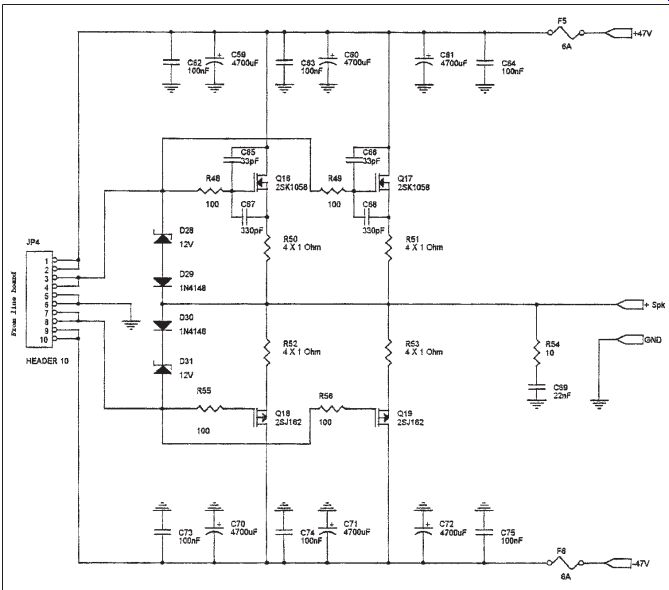
FIGURE 3: 100W power-board schematic. G
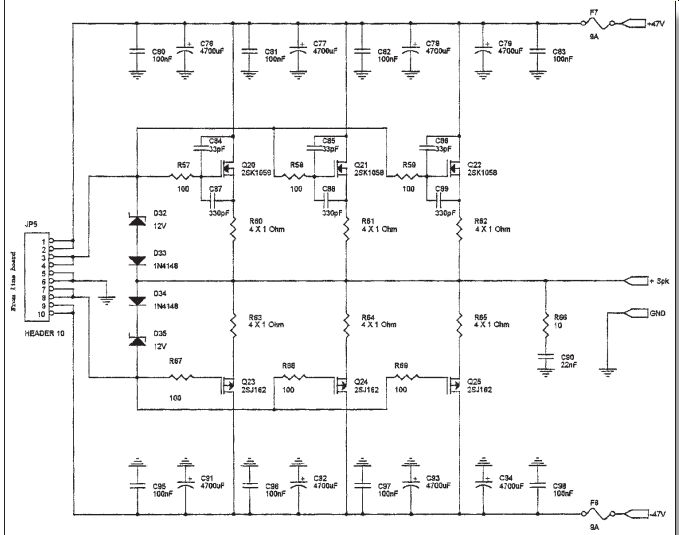
FIGURE 4: 150W power-board schematic.
GREAT ELECTRICAL PERFORMANCE
The electrical performance of such a power stage is remarkable: almost no added distortion, a very high damping factor, a large amount of current delivered to the load, and extremely low out put resistance. Now the question is how to drive it ? It's true that MOSFETs are voltage driven, but they have a considerably high source-to-gate and gate to-drain capacitance, which means they do absorb current from the driver when a signal is applied to the gates.
Even if the SRPP has relatively low out put resistance, it would not be able to drive four pairs of MOSFETs.
Now imagine that all the input capacitance of eight devices is paralleled. This requires an extra driver stage, based on a tube so it can be directly coupled to the SRPP and loaded by a solid-state constant-current generator in order to enhance its performance. I paralleled two sections of an ECC82/ 12AU7 to increase the current flow and reduce the output resistance.
The power stage is biased through a resistor net work, where you will find two trimmers, one to set the bias current, and the other to correct and eliminate the DC offset.
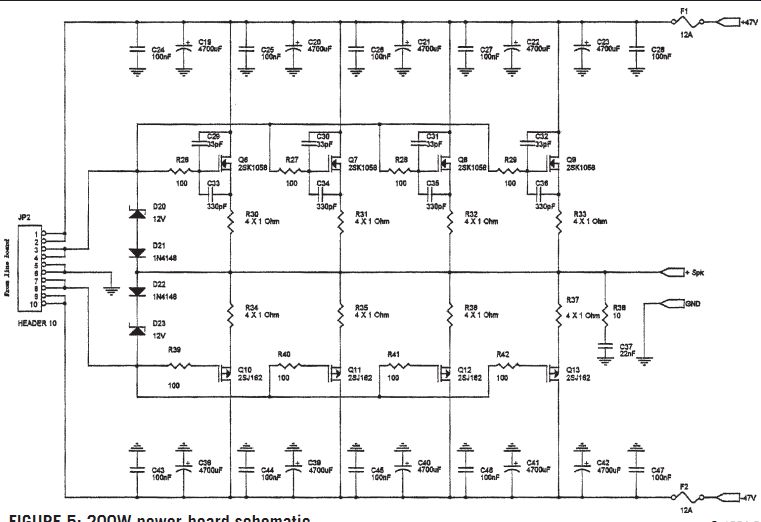
FIGURE 5: 200W power-board schematic.
What about the relay? During tube warm-up, the voltage on the driver's cathode increases slowly until it is about half the supply voltage. Now this volt age is not constant, but variable, so it will pass through the coupling capacitors and the power stage will amplify it until the driver's cathode is at its fixed potential. As a result, you have a huge DC voltage with almost no current limitation on your speakers. You can imagine what will happen.
During tube warm-up, the relay will short R9 and R19, connecting the gates directly to the biasing network, which has low resistance. In this way, the volt age swing on the driver's cathodes passing through the coupling caps will be absorbed by the biasing network and will not drive the power stage. The speakers are safe now! This is how the amp works. Now let's examine the reasons for some tricks you will probably notice while looking at the schematics.
CIRCUIT TRICKS
Consider the input plug. The negative lead is not grounded, but is connected to the R17/R21 node. R21 is not there to provide local feedback to the input stage since its value is too low, but it acts as a ground decoupler. I had some trouble with noise and hum, and this was the easiest way to make the amp mute.
This trick, often used in preamplifiers and solid-state amps, is very simple and works well, but if your amp is still noisy due to a ground-loop caused by the input connections between the amp and preamp, try increasing R21 up to 15 ohm. Bear in mind, however, that there may be other causes that make the amp noisy; in any case, check your layout first.
On the power boards, there are a couple of zeners, called "clippers," between the gates and the speaker outputs that limit the current flow to 12A through each device, since a higher current might cause them to fail.
I said before that MOSFETs have high interelectrode capacitance, but P devices have higher capacitance than do N devices, and since the power-stage design is electrically symmetrical, all N devices must be compensated. To do this, increase their internal capacitance with two capacitors mounted as close as possible to each MOSFET so they will all have identical capacitance.
This will make the power stage more reliable by decreasing intermodulation distortion at high frequencies and in creasing bandwidth.
-----------------
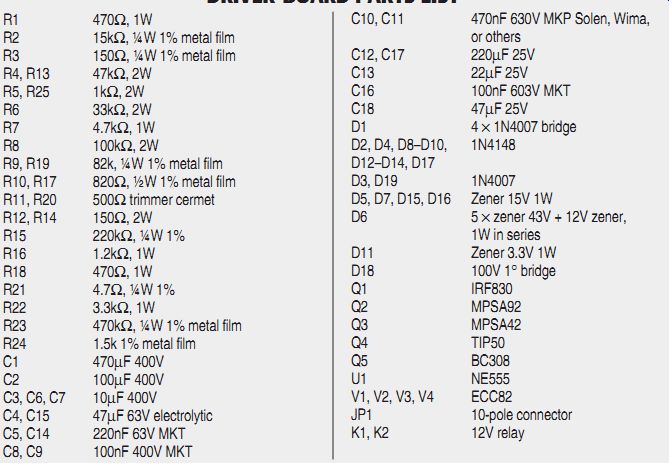
TABLE 1 DRIVER-BOARD PARTS LIST
R1 470 ohm, 1W R2 15k ohm, ¼W 1% metal film R3 150 ohm, ¼W 1% metal film R4, R13 47k ohm, 2W R5, R25 1k ohm, 2W R6 33k ohm, 2W R7 4.7k ohm, 1W R8 100k ohm, 2W R9, R19 82k, ¼W 1% metal film R10, R17 820 ohm, ½W 1% metal film R11, R20 500 ohm trimmer cermet R12, R14 150 ohm, 2W R15 220k ohm, ¼W 1% R16 1.2k ohm, 1W R18 470 ohm, 1W R21 4.7 ohm, ¼W 1% R22 3.3k ohm, 1W R23 470k ohm, ¼W 1% metal film R24 1.5k 1% metal film C1 470µF 400V C2 100µF 400V C3, C6, C7 10µF 400V C4, C15 47µF 63V electrolytic C5, C14 220nF 63V MKT C8, C9 100nF 400V MKT C10, C11 470nF 630V MKP Solen, Wima, or others C12, C17 220µF 25V C13 22µF 25V C16 100nF 603V MKT C18 47µF 25V D1 4 × 1N4007 bridge D2, D4, D8-D10, 1N4148 D12-D14, D17 D3, D19 1N4007 D5, D7, D15, D16 Zener 15V 1W D6 5 × zener 43V + 12V zener, 1W in series D11 Zener 3.3V 1W D18 100V 1° bridge Q1 IRF830 Q2 MPSA92 Q3 MPSA42 Q4 TIP50 Q5 BC308 U1 NE555 V1, V2, V3, V4 ECC82 JP1 10-pole connector K1, K2 12V relay
-----------
On all the MOSFETs' source pins, four 1 ohm resistors are paralleled (on the schematics, only one resistor is shown). This is because power resistors have a little leakage inductance due to the way they are constructed (they are usually made of a wire wound on a ceramic base).
The advantage of having four resistors paralleled is that you can use 1 ohm carbon or metal-film resistors that have no leakage inductance, which is very important in maintaining a stable and reliable operation.
To make this amp work, you will need the driver board (Fig. 1) and one of the four proposed power stages (Figs. 2-5), which you just plug into the driver stage to enjoy your favorite music! The driver-board parts list is in Table 1, and the parts lists for the power stages are in Table 2.

TABLE 2
POWER-STAGE PARTS LISTS
---------------
TWO-MOSFET: R43, R47 100 ohm, ¼W 1% metal film R44, R45 4 × 1 ohm, 1W paralleled R46 10 ohm, 4W C48, C49, C55, C56 4700µF 63V C50, C51, C57, C58 100nF 100V MKT C52 33pF C53 330pF C54 22nF 100V MKT D24, D27 Zener 12V ½W D25, D26 1N4148 Q14 2SK1058 Q15 2SJ162 F3, F4 Fuse 3A JP3 10-pole connector FOUR-MOSFET:
R48, R49, R55, R56 100 ohm, ¼W 1% metal film R50-R53 4 × 1 ohm, 1W paralleled R54 10 ohm, 4W C59-C61, C70-C72 4700µF 63V C62-C64, C73-C75 100nF 100V MKT C65, C66 33pF C67, C68 330pF C69 22nF 100V MKT D28, D31 Zener 12V ½W D29, D30 1N4148 Q16, Q17 2SK1058 Q18, Q19 2SJ162 F5, F6 Fuse 6A JP4 10-pole connector SIX-MOSFET:
R57-R59, R67-R69 100 ohm, ¼W 1% metal film R60-R65 4 × 1 ohm, 1W paralleled R66 10 ohm, 4W C76-C79, C91-C94 4700µF 63V C80-C83, C95-C98 100nF 100V MKT C84-C86 33pF C87-C89 330pF C90 22nF 100V MKT D32, D35 Zener 12V ½W D33, D34 1N4148 Q20-Q22 2SK1058 Q23-Q25 2SJ162 F5, F6 Fuse 9A JP5 10-pole connector EIGHT-MOSFET:
R26-R29, R39-R42 100 ohm, ¼W 1% metal film R30-R37 4 × 1 ohm, 1W paralleled R38 10 ohm, 4W C19-C23, C38-C42 4700µF 63V C24-C28, C43-C47 100nF 100V MKT C29-C32 33pF C33-C36 330pF C37 22nF 100V MKT D20, D23 Zener 12V ½W
D21, D22 1N4148 Q6-Q9 2SK1058 Q10-Q13 2SJ162 F1, F2 Fuse 12A JP2 10-pole connector
-----------------
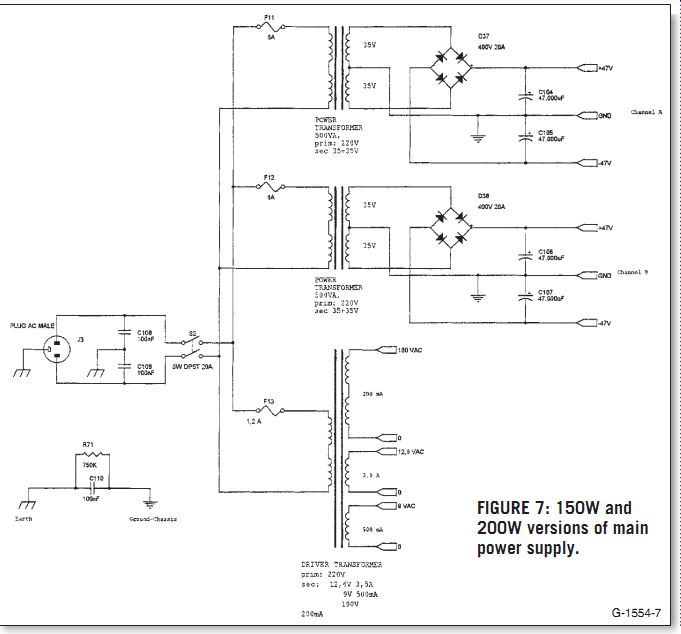
FIGURE 7: 150W and 200W versions of main power supply.
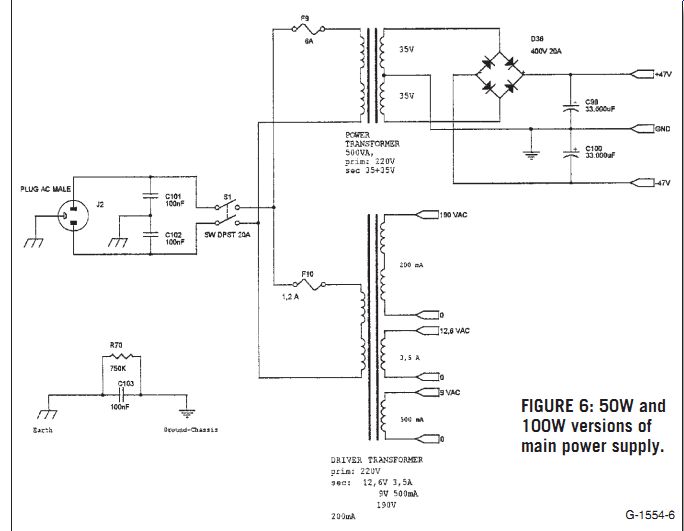
FIGURE 6: 50W and 100W versions of main power supply.
POWER SUPPLIES
The input stage's power supply is regulated; the circuit is the same as one I have used on the SV572-10 amplifier. A constant-current generator fixes a current through the zener series, and an npn transistor drives a power MOSFET used as a series regulator. This power supply, housed on the driver board, is the same for all versions.
I mentioned before that this amp was designed to have a very high-performing power stage; as a consequence, its power supply must be very tough. Each version has its dedicated power supply (Figs. 6 and 7) giving cur rent to the power stage. As you can see, these supplies are somewhat over sized because they must act as great energy reservoirs capable of delivering high peaks of current.
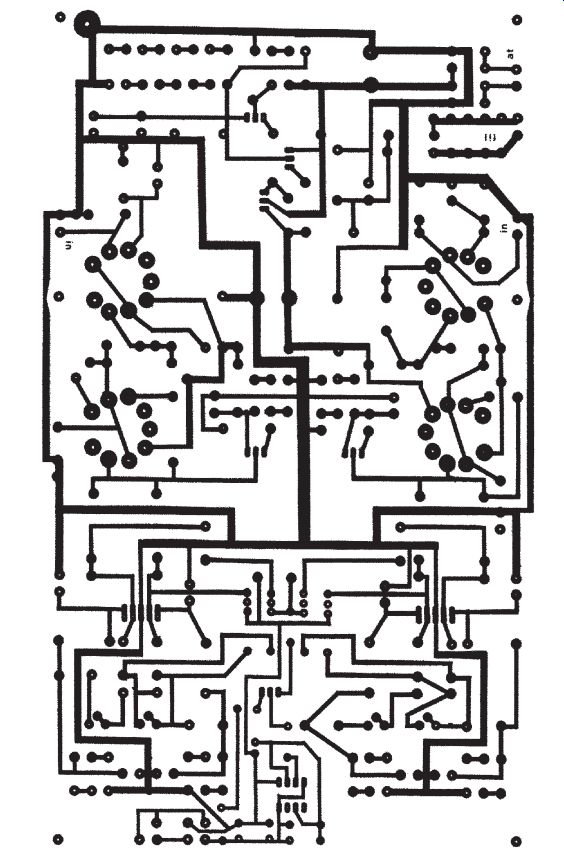
FIGURE 9: Driver-stage board.

FIGURE 8: Power-stage board. _
-----------------
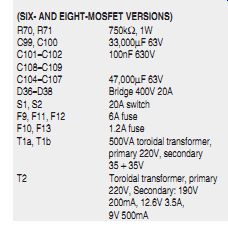
TABLE 3
MAIN POWER-SUPPLY PARTS LIST
(SIX- AND EIGHT-MOSFET VERSIONS) R70, R71 750k ohm, 1W C99, C100 33,000µF 63V C101-C102 100nF 630V C108-C109 C104-C107 47,000µF 63V D36-D38 Bridge 400V 20A S1, S2 20A switch F9, F11, F12 6A fuse F10, F13 1.2A fuse T1a, T1b 500VA toroidal transformer, primary 220V, secondary 35 + 35V T2 Toroidal transformer, primary 220V, Secondary: 190V 200mA, 12.6V 3.5A, 9V 500mA
-----------------
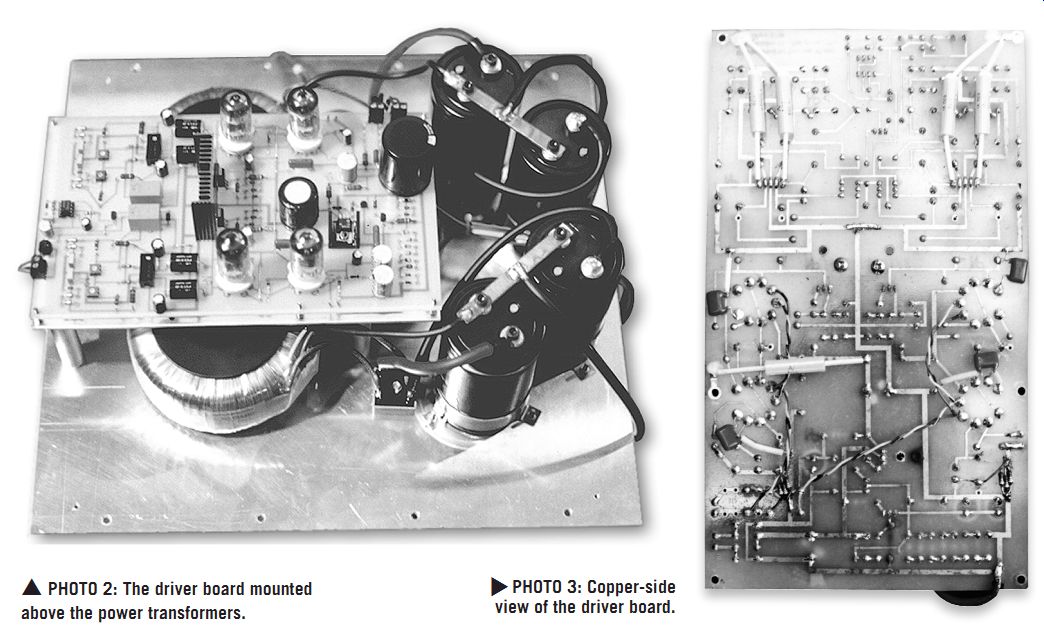
PHOTO 2: The driver board mounted above the power transformers.
PHOTO 3: Copper-side view of the driver board.
_
On the 8-MOSFET version of the power-stage board (Fig. 8), you will find ten capacitor cans mounted and paralleled five by five. This is still part of the power-supply design: five small capacitors paralleled have a lower Resr than an equivalent single capacitor, and finally, each power MOSFET is connected directly to the closest capacitor, al lowing a very short connection between the power device and its power supply.
Unfortunately, having the filtering capacitance directly on the power board is very expensive. It also takes a lot of space, which necessitates having very long routes on the PCB-not a healthy situation. So additional capacitors are mounted on the amplifier's chassis to allow you to reach the de- sired capacitance value. Refer to Table 4 for the appropriate values for each power-stage supply.
The 6 and 8 MOSFET versions have a double power-stage power supply, with separated transformers and filtering units for each channel, while all other versions have a common power supply for both channels. Finally, the driver board is supplied by its dedicated power transformer.
Whatever version you choose to build will have a two-channel driver board with its power transformer and two power boards with their power sup plies. Just plug one of the power stages into the driver board, and your amp will start working.
MOUNTING THE DRIVER BOARD
First of all you must make your PCB (Fig. 9, Photo 1) and have someone cut a 3mm-thick aluminum board with the PCB's dimensions to shield the driver stage from the power transformers. In my layout, the power transformers are mounted just under the driver board, which I know is not the optimum solution, but I lacked enough space in my standard four-unit 19” rack.
On the driver board, all connections between parts are routed except for the filament supply. Don't forget that filaments are 12.6V operated, so you must connect the 12.6V to pins 5 and 6, leaving pin 9 unconnected on all tube sockets. Once you have your PCB finished, mount it on the aluminum board, leaving a 15-20mm space be tween them (Photo 2).
In order to reduce hum, connect a 100nF 400V capacitor between pin 9 of each tube socket and the aluminum board (Photo 3). The same must be done for each DC supply: the high-voltage drivers' supply and both positive and negative legs of the power stage's sup ply coming from the power boards to the 10-pin connectors you find on your driver board. All this is not strictly necessary, but it will help in reducing hum.

TABLE 4: POWER-STAGE POWER SUPPLY
--------------
VERSION TRANSFORMER RATINGS CHASSIS CAPACITANCE VALUE
2 MOSFETs per channel
One 500VA, sec 35 + 35V AC 33,000µF per leg 4 MOSFETs per channel One 500VA, sec 35 + 35V AC 33,000µF per leg 6 MOSFETs per channel Two 500VA, sec 35 + 35V AC 47,000µF per leg 8 MOSFETs per channel Two 500VA, sec 35 + 35V AC 47,000µF per leg
--------------
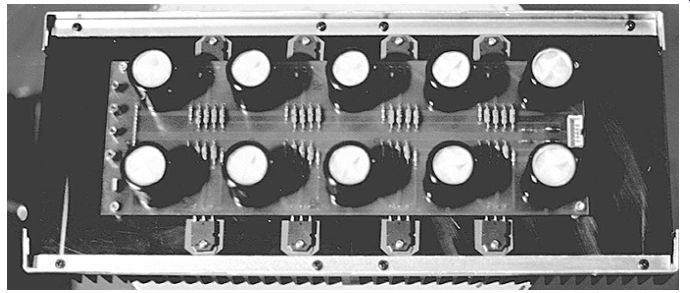
PHOTO 4: Power board mounted on the heatsink.
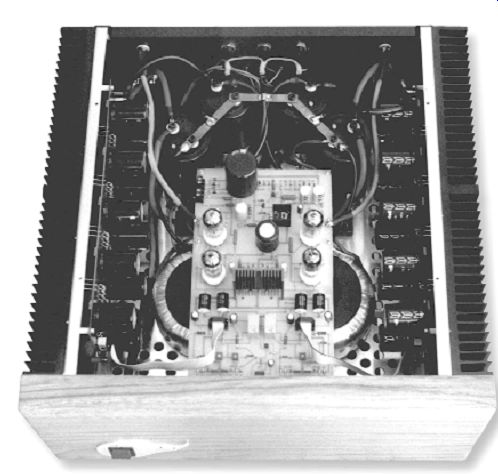
PHOTO 5: Top view of the 8-MOSFET version.
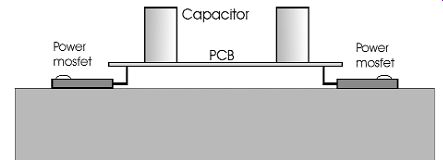
FIGURE 10: MOSFET mounting diagram.
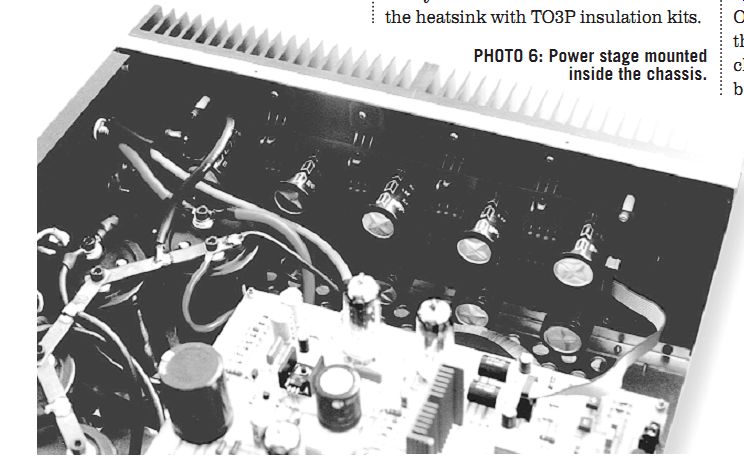
PHOTO 6: Power stage mounted inside the chassis.
---------------

TABLE 5 BIAS TABLE
VERSION BIAS CURRENT 2 MOSFETs per channel 120mA 4 MOSFETs per channel 210mA 6 MOSFETs per channel 310mA 8 MOSFETs per channel 400mA
------------------
The driver-board layout (Fig. 9) is not updated with the ground decoupling network. You will need to cut the ground routes next to the inputs and solder R21 under the PCB.
Next to the zener series there is a large ground connection that must be made directly to the power-stage power supply's ground on the capacitors leads. This is the main ground connection between all power supplies.
MOUNTING THE POWER BOARDS
I have mounted and tested a prototype of each version, but I have finished only the most powerful one (8-MOS FET version), so everything I say from now on refers to this amp's layout and construction. But don't worry if you in tend to build one of the smaller versions, because they all have many things in common, from the design to the final layout and construction.
Mounting these boards won't cause any trouble (Photo 4). By the way, pay attention when you mount the capacitors: the power sup ply has a positive and a negative lead with respect to the ground, so make certain the polarities of all electrolytic caps are correct. The positive lead supplies all the 2SK1058 MOSFETs, while the negative lead is connected to the 2SJ162 devices.
On the other side of the board, you may mount a 100nF 100V MKT capacitor under each 4700µF can; just solder each film cap directly to the 4700µF capacitor pins. There was not enough space on the component side of the PCB.
All MOSFET pins must be bent at 90° and soldered to the copper side of the board so that you can mount the power devices on the heatsink. Figure 10 and Photo 4 may explain much better than words how you do this job. Don't forget that you must mount all MOSFETs on the heatsink with TO3P insulation kits.
PHOTO 6: Power stage mounted inside the chassis.
DISSIPATING HEAT
All solid-state devices produce much heat that must be dissipated. You will need a couple of large heatsinks. The best is one of those 19” racks with heatsinks on its sides. A four-unit and 400mm-deep rack is required for the 8 MOSFET version (Photos 5 and 6). The 6- and 4-MOSFET versions will fit into three-unit racks, and I think the two unit rack is sufficient for the smallest version of the system.
There are precise formulas and procedures for calculating the optimal heatsink dimensions according to the amount of power you must dissipate, but it would take too much space to de scribe all this. A little suggestion, how ever: when you mount a power device on a heatsink with its insulation kit, the rule of thumb is to be sure the heatsink is large enough so the running temper ature never rises above 50-55°C. If you can still keep your hands on it without being burned, it means the temperature is 55°C, or less. But if the heatsink be comes too hot, you will need to mount a larger one.
CHASSIS LAYOUT
Once you have finished mounting the three boards, begin to think about the chassis layout. In my rack, the bottom board was not strong enough, so I re placed it with a 3mm-thick aluminum board. If you have the same problem, you will need to drill large holes in the board so that air may flow inside the box.
As you can see from Photo 7, I mounted the three power transformers in the mid-front side of the chassis, the capacitor cans in the rear, and the bridges between them.
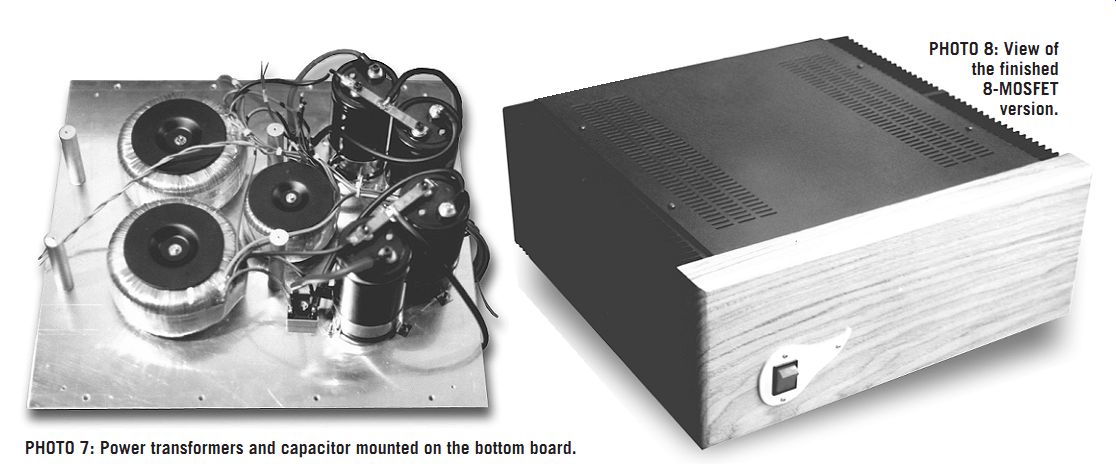
PHOTO 8: View of the finished 8-MOSFET version. PHOTO 7: Power transformers
and capacitor mounted on the bottom board.
The driver board is elevated above the power transformers with four aluminum bars (Photo 2), and all secondaries of the driver-stage transformer are connected to the driver board. Both center taps of the two 500VA power transformers are wired to the main ground connection, which is directly on the capacitor leads. From there you must ground the chassis, the driver board, and both power PCBs. You must wire the positive and negative legs of the power-stage power supply from each bridge to the capacitor cans (watch out for the polarity!), and from the capacitors to the power boards.
The power-stage power supplies must be wired with 4mm wires. I have used 6mm wires, which you can do as well, but consider that they are not easy to solder. You will need a very big and powerful soldering iron.
I made the ground connections be tween the capacitor cans with a 10 × 2mm copper bar, giving a very clean look to the layout (Photo 5). But, again, it's really hard to solder a 6mm wire on it! Don't forget that the input plugs must be isolated from the chassis electrical ground. Finally, you will need a ten-wire flat cable to connect the power PCBs to the driver board.
FIRST START-UP AND TUNING
Once you have finished mounting, check your layout carefully. Disconnect the power stage's power supplies, turn the amp on, and be sure that the input stages do their job correctly (if you have a scope, use it!). Check the delay circuits 15 to 20 seconds after power is on.
The relay shorts R9 and R19. After a few seconds' delay, the relay contact opens, un-shorting R9 and R19.
Turn the bias trimmer R11 until it shorts and the offset trimmer R20 half way. You must tune one channel at a time, so leave one of the two power sup plies disconnected and connect a DC milliammeter in series with the positive leg of the power stage's power supply of the channel you are currently tuning.
Then connect to the output a DC volt meter paralleled to a 10 ohm resistor.
Switch the amp on and turn the offset trimmer until you read 0V on your millivoltmeter; then set the proper bias current. Refer to Table 5 (the bias table) and look for the current required by the power stage you have built.
Wait until the heatsink has reached its running temperature and make the corrections needed to both bias current and offset. Be sure that the ammeter leads do not become disconnected while you are tuning the amp, or you will blow all the power devices! Repeat these few steps on the other channel, but before doing so, you must wait a couple of minutes until the capacitors are discharged; or you may discharge them yourself with a 1k 10W resistor connected between the positive and negative legs of the power supply.
Be very precise with the offset tuning. A 20-30mV offset is still permissible, but a 100-200mV voltage is not good for your speakers. Remember that all tunings on the power stage must be done with a 10 ohm 10W resistor load connected to the outputs.
MEASUREMENTS
At low levels, the THD is mainly due to the input stage, thanks to the power stage complementary follower configuration, which does not affect the signal in a significant way. THD increases at higher levels, since the power stage gradually switches from Class A to Class AB operation.
The graph in Fig. 11 reveals what the 8-MOSFET version is able to do, showing how the power stage reacts with different load impedances. The measurement has been done at full power (soft clipping) in both continuous and intermittent range (the test signal is a pulse signal). You may notice that it looks almost like a straight line, which indicates there is almost no voltage drop when a huge amount of current is required.
----------------------

TABLE 6
MEASUREMENT TABLE
OUTPUT POWER
2-MOSFET version 45W 4-MOSFET version
92W 6-MOSFET version 138W 8-MOSFET version 185W
Frequency response 15-60,000Hz -3dB THD 0.18% 1W@ 1kHz
--------------------------
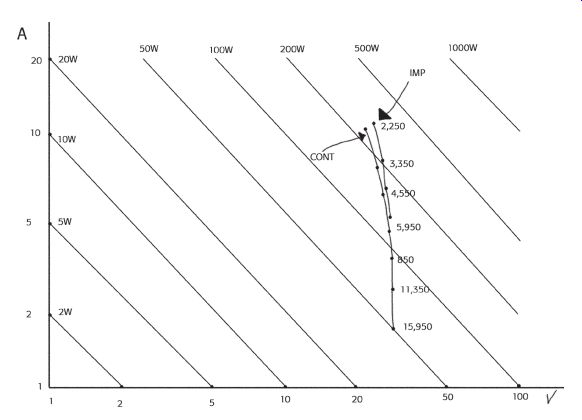
FIGURE 11: Driving performance of the 8-MOSFET power stage at different
load values.
All measurements are referred to the 8-MOSFET version except for output power.
As a result, you can see the benefits of the choices in both power-stage and power-supply design. Refer to Table 6 for further details.
LISTENING IMPRESSIONS
I conducted all listening tests using the following equipment: a Pioneer PD507 CD player with custom output stage, a 6SN7 single-ended buffered by a cathode-follower preamplifier, and Magneplanar MG1.6 speakers.
In all versions, the timbre at low levels was substantially the same.
What I said previously was correct:
the input stage is the one that forms the sound of the amp. The timbre is very bright, but well balanced, with every detail clear. The high range is very precise, the bass is powerful and well damped, and the mid-frequencies are present and well linked with the upper and lower range.
Sometimes I sense that it is a bit rough in the midband, but less so than in push-pull tube amps. Consider, however, that I am currently influenced by the sound of the SV572-10 single-ended amp.
The virtual image is well focused.
Voices and instruments are precisely defined and their images are very stable inside the virtual scene, giving a great sense of depth.
The 2-MOSFET version has very good driving performance, but when high power is required, the image becomes a little confused. I think this is due to the fact that the power stage switches to Class AB at a relatively low output power.
This does not happen with the 8-MOSFET version, since Class A is guaranteed up to 50W.
The 200W version has extra ordinary driving performances and damping factor. While mid and high-range performances are substantially identical for all versions, the 8-MOSFET-per channel amp (Photo 8) has an excellent bass response and striking dynamic range, allowing the best reproduction of every kind of music.
I love playing music with this amp at very low levels, because every instrument is so present and detailed, and the dynamic range is so wide, even when the speakers are just whispering.
----------------------
Also see: